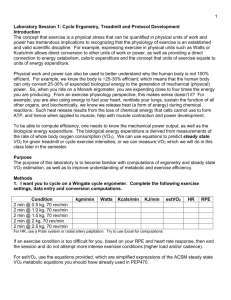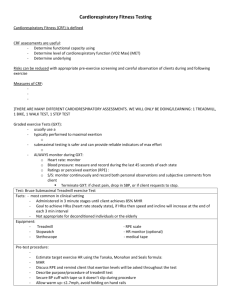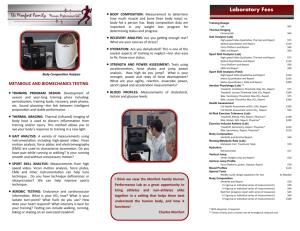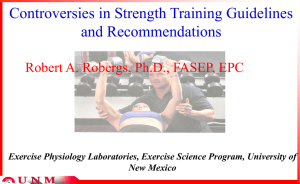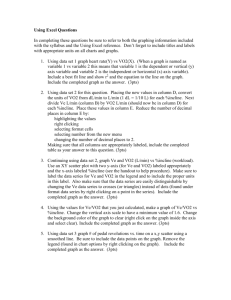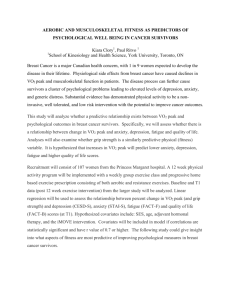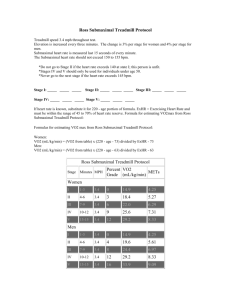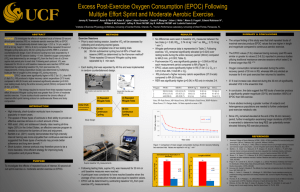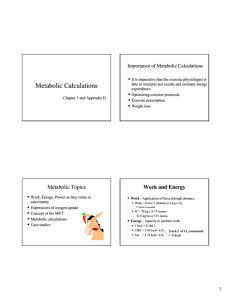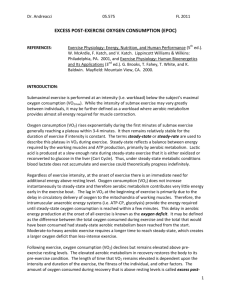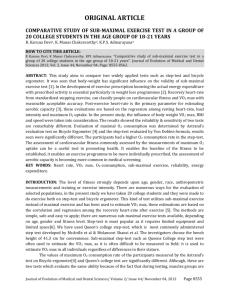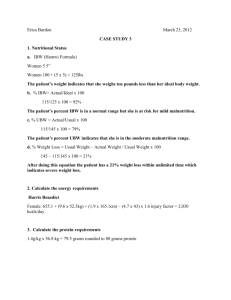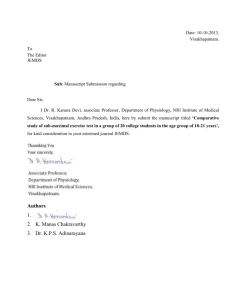Laboratory Session 2
advertisement
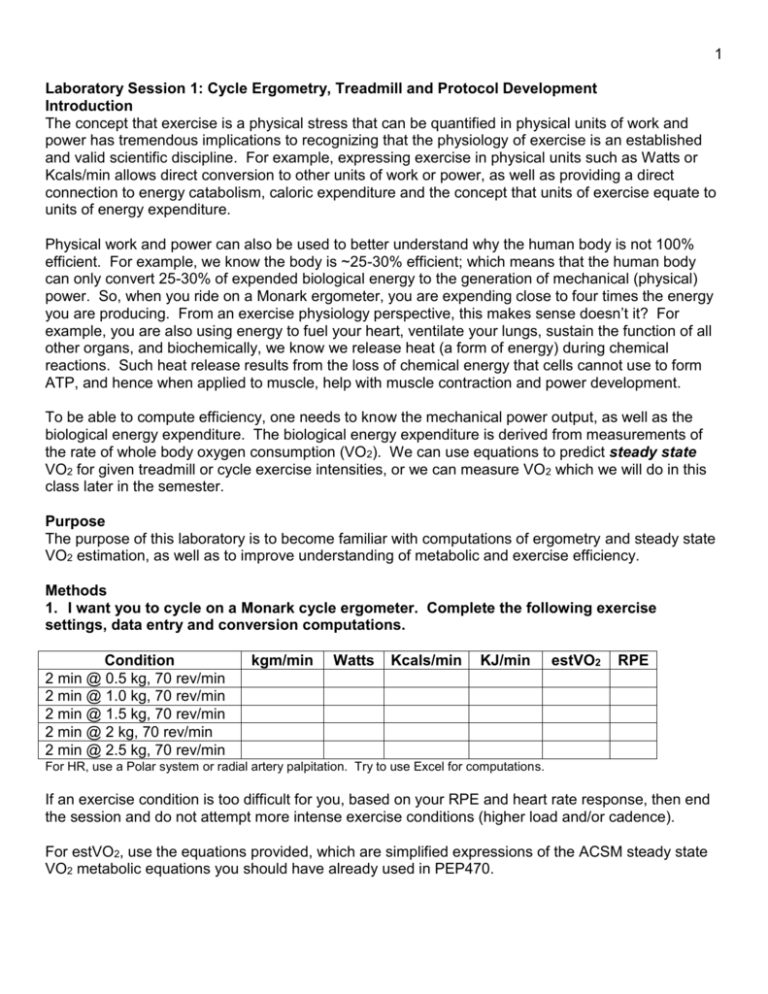
1 Laboratory Session 1: Cycle Ergometry, Treadmill and Protocol Development Introduction The concept that exercise is a physical stress that can be quantified in physical units of work and power has tremendous implications to recognizing that the physiology of exercise is an established and valid scientific discipline. For example, expressing exercise in physical units such as Watts or Kcals/min allows direct conversion to other units of work or power, as well as providing a direct connection to energy catabolism, caloric expenditure and the concept that units of exercise equate to units of energy expenditure. Physical work and power can also be used to better understand why the human body is not 100% efficient. For example, we know the body is ~25-30% efficient; which means that the human body can only convert 25-30% of expended biological energy to the generation of mechanical (physical) power. So, when you ride on a Monark ergometer, you are expending close to four times the energy you are producing. From an exercise physiology perspective, this makes sense doesn’t it? For example, you are also using energy to fuel your heart, ventilate your lungs, sustain the function of all other organs, and biochemically, we know we release heat (a form of energy) during chemical reactions. Such heat release results from the loss of chemical energy that cells cannot use to form ATP, and hence when applied to muscle, help with muscle contraction and power development. To be able to compute efficiency, one needs to know the mechanical power output, as well as the biological energy expenditure. The biological energy expenditure is derived from measurements of the rate of whole body oxygen consumption (VO2). We can use equations to predict steady state VO2 for given treadmill or cycle exercise intensities, or we can measure VO2 which we will do in this class later in the semester. Purpose The purpose of this laboratory is to become familiar with computations of ergometry and steady state VO2 estimation, as well as to improve understanding of metabolic and exercise efficiency. Methods 1. I want you to cycle on a Monark cycle ergometer. Complete the following exercise settings, data entry and conversion computations. Condition 2 min @ 0.5 kg, 70 rev/min 2 min @ 1.0 kg, 70 rev/min 2 min @ 1.5 kg, 70 rev/min 2 min @ 2 kg, 70 rev/min 2 min @ 2.5 kg, 70 rev/min kgm/min Watts Kcals/min KJ/min estVO2 RPE For HR, use a Polar system or radial artery palpitation. Try to use Excel for computations. If an exercise condition is too difficult for you, based on your RPE and heart rate response, then end the session and do not attempt more intense exercise conditions (higher load and/or cadence). For estVO2, use the equations provided, which are simplified expressions of the ACSM steady state VO2 metabolic equations you should have already used in PEP470. 2 2. Complete the following treadmill exercise settings, data entry and conversion computations. Condition 2 min @ 4.0 mi/hr, 0 %grade 2 min @ 4.0 mi/hr, 2 %grade 2 min @ 5.0 mi/hr, 0 %grade 2 min @ 5.0 mi/hr, 4 %grade 2 min @ 6.0 mi/hr, 1 %grade estVO2 HR RPE For HR, use a Polar system or radial artery palpitation. Try to use Excel for computations. 3. For two of your cycle ergometry exercise conditions (must be those that were steady state!), calculate a typical mechanical efficiency based on the following a. Convert Watts to Kcals/min (mechanical) and convert estVO2 to Kcals/min (biological) for the lower and higher intensity data. For estVO2 Kcal/min conversion, assume an RER=0.90. Kcals/min = estVO2 (L/min) x Kcals equivalent for the RER. b. Efficiency (%) c. Remember that your efficiency computation is an average value, as it is based on the predicted estVO2. Your actual efficiency could be a little different based on what your true steady state VO2 is for the Watts conditions. d. Make sure you show your computations in your lab report. 4. Using the protocol development program, prepare a protocol for yourself for each of cycle ergometry and treadmill running. Enter your data in the protocol table linked to the assignment page. For the treadmill protocol, remember to first establish what a good running/walking pace is for you. You should increment to this pace through minute 4, and then use %grade to further increase exercise intensity. Try to make each increment as consistent as possible over the entire protocol, so that the estimated VO2 stair case response a consistent linear function. Work on this with diligence, as you will use protocol development on numerous occasions during this class! It is important that you understand the connections between increments in exercise intensity and the resulting increase in metabolic demand (VO2). Results Present the completed cycle ergometer and treadmill data tables. Graph heart rate (y-axis) to estVO2 (x-axis). What is the slope of this response? Graph heart rate (y-axis) to estVO2 (x-axis). What is the slope of this response? The Kcals/min data for cycling are for mechanical energy production. How could these be adjusted to account for biological energy expenditure? Present your efficiency calculations. 3 Discussion Be able to define what steady state means in exercise physiology. How long does it take to reach steady state for a typical exercise transition? Why should you only use the VO2 prediction equations for steady state exercise? Why do I get you to convert Kcals/min to Kjoules/min? Why are there no data for mechanical energy expenditure from the treadmill? Why is the duration of an incremental protocol important when measuring VO 2max? References Mallory LA, Scheuermann BW, Hoelting BD, Weiss ML, McAllister RM, Barstow TJ. Influence of peak VO2 and muscle fiber type on the efficiency of moderate exercise. Med Sci Sports Exerc. 2002 Aug;34(8):1279-87. Robergs RA. Exercise Physiology: An Electronic Text and Learning Experience. NEXSIS, Albuquerque, NM, 2008. Yoon BK, Kravitz L, Robergs R.A. VO2max, protocol duration, and the VO2 plateau. Med Sci Sports Exerc. 2007 Jul;39(7):1186-92. Note: If you do not schedule time in the lab for this work (make sure Joan, or somebody, enters your session into the book), you will get a “0” grade! You must get your buts into the lab!!!!
